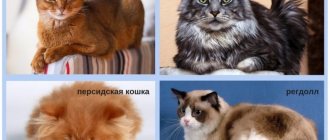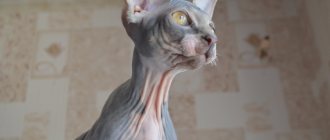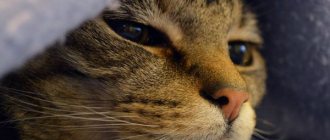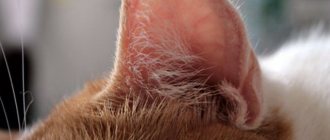Origin story
There are three popular types of sphinxes:
- Canadian;
- Don;
- Petersburg (Peterbald).
The first mentions of hairless cats date back to the 4th century. BC e. In Ancient Egypt they were revered and believed that they were able to communicate with the gods and the world of the dead. According to another version, the ancestor of the Sphinx is a hairless Mexican cat, which was tamed by the ancient Aztecs.
The ancient Egyptians had a cult of cats
The history of the Canadian breed begins in the city of Ontario in 1966. An ordinary cat gave birth to a hairless kitten. The baby was named Prune. Breeders made several attempts to mate the animal with other cats, as a result of which several healthy specimens were born. Scientists faced an important task - to obtain a genetically healthy breed. The first attempts were unsuccessful: due to too close family ties and a small gene pool, the kittens were too weak and often died.
In 1975, a hairless kitten was born in Wadena (USA), who was named Epidermis, and in 1976, a hairless cat was born in the same state. Their offspring are the founders of the modern Sphynx breed. Thanks to the efforts of American breeders, the recessive gene was fixed, and the breed was recognized by the WCF, and later by other felinological organizations in the world.
The Don Sphynx is not related to the Canadian Sphynx. In 1987, in Rostov-on-Don, a woman found a stray cat on the street with signs of baldness. She took pity on her, sheltered her and named her Varvara. Gradually, the pet’s hair began to fall out, and veterinarians unsuccessfully tried to treat her for lichen and other diseases for 4 years. Soon the cat gave birth to three hairless kittens, only one of which survived - the girl Chita. Her descendants became the founders of a new breed - the Don Sphynx. Cats received official recognition in 1996, at which time the first breed standard was adopted.
St. Petersburg Sphynxes were bred by felinologist M. S. Mironova by crossing the Don Sphynx and the Oriental breed in the city of St. Petersburg. The kittens received the gene for lack of hair from their father, and from their mother they received a graceful physique, long legs and a pointed head. The breed was officially recognized in 1996 and by the WCF in 2003.
Exterior
At first glance, all sphinxes are similar. But there are differences in the structure of the head and body, and sometimes they are significant.
The main differences between Sphynx breeds
Table: characteristics of the Canadian, Don and St. Petersburg sphinxes
| Sign | Sphynx breed standard | ||
| Canadian | Donskoy | Peterbald | |
| Head | Wedge-shaped, with rounded contours, short muzzle. | Small and elongated, wedge-shaped, with pronounced cheekbones and eyebrows, disproportionate to the body. | Wedge-shaped, pointed head, long and straight nose, smooth transition of the head into a thin, graceful neck. |
| Eyes | Large, expressive eyes, round or lemon-shaped. The color should be in harmony with the coat. | Oval or almond-shaped, any color. | Medium slanting almond-shaped, color can be green or blue. |
| Ears | Very large, widely spaced, widened at the base, rounded at the tips. | Large, tilted forward. | They are large, the tips are sharp and point to the sides. |
| Vibrissae | Short. | Short (broken), curled or missing. | Short, curved mustache is absent or present. |
| Neck | Medium length, muscular. | Long, graceful. | Graceful, long. |
| Body type | Harmonious, medium size, massive chest. The weight of an adult is 3 - 6 kg. | Strong and dense, wide chest, developed muscles. Average size, weight of adult cats - 3 - 7 kg. | Elegant and graceful, the shape is elongated, the hips and shoulders are the same width. Small cats, average weight - 2.5 - 4 kg. |
| Paws | The front ones are slightly curved, the rear ones are longer than the front ones. | Small, neat. | Feature: long toes. |
| Tail | Hairless, sometimes with a lion topknot, proportional to the body. | Straight, bare tip, rounded. | Long, sharp and thin, like a whip. |
| Coat | The skin may be bare, but more often it is covered with short and thin down or hair (no more than 2 mm), which feels like suede to the touch. | Most often they are completely hairless, but they can also have a little fluff or be covered with short hair (brush, flock, velor). | They can be bald (but such individuals are considered defective) and have fur (brush, flock, velor). There are also individuals with regular fur. |
| Folds | Lots of folds all over the body. Kittens are born wrinkled, but with age, the folds partially disappear, remaining on the head and neck, and sometimes on the body. The more folds, the more valuable the specimen. | Compared to the Canadian Sphynx, there are fewer folds. They are located mainly on the head and neck. | There are a lot of folds on the head, fewer on the body. |
| Peculiarities | The body temperature of an adult cat is 38 - 39 degrees, so it is always hot to the touch. | The skin is elastic, soft, hot, similar to human skin. In the fall, cats accumulate fat, which gradually disappears by spring. | Curved front paws are a sign of marriage. |
Photo gallery: Canadian, Don, St. Petersburg sphinxes
Sphynx kittens are born wrinkled
A distinctive feature of the Canadian Sphynx is its huge ears and large round eyes.
The Canadian Sphynx is calm and proud
Many folds are a sign of valuable representatives of the Canadian Sphynx
An amazing creature that amazes and delights with its appearance - the Don Sphynx
The Don Sphynx has a large body and a small head
A distinctive feature of Peterbalds is their long and thin toes.
Peterbald is graceful and graceful, like an oriental cat
Peterbald ears point to the sides
Sphynx kittens of all varieties are cute
Video: Canadian Sphynx
Interesting facts about sphinxes
The skin of Sphynx cats is covered with folds and wrinkles. If you look closely, you can see a strong resemblance to human skin. It is also interesting that cats sweat all over their bodies. Sweat has a specific smell and leaves dark spots on the animal’s body. The body of hairless cats is very hot. It's all about the absence of wool - the body directly gives off heat. Therefore, despite their warm body, sphinxes must be protected from the cold. They love to bask on a radiator or under a table lamp - it is necessary to create conditions for them in which the cat could always find a warm and cozy place. Keep in mind that your pet can get sunburned in the sun! Control your sunbathing and get used to tanning gradually. The less hair and fluff there is on a kitten, the more bald the adult cat will be. Sphinxes are very difficult to tolerate any disease, they quickly develop dehydration, and quickly lose strength. At the first sign of a serious illness, it is recommended to take the animal to the veterinarian. Sphynxes are devoid of hair, but in some places it is partially retained or grows back due to hormonal surges. There are hairs or fluff on the muzzle and head, paws, and at the tip of the tail.
1 of 7
Coat and colors
The accepted classification is:
- Naked. Kittens are born completely naked; these specimens are the most valuable and expensive. They are homozygous and undressed (in newborn kittens, fluff is noticeable, which soon disappears).
- Flock. The coat is short, soft and almost invisible. The fur is sparse. Often gradually disappears completely.
- Velours. The coat is well felt to the touch, the hair is longer. The kitten looks hairless, but if you run your hand, you can feel that this is not so. At about a year, the hair begins to fall out, remaining only on the paws and head. Varieties of velor sphinxes: light velor, point velor, down velor.
- Brush. The kitten is born with dense and curly hair and curled whiskers. There are three varieties: brush velor, brush point, dense brush. The coat may remain or disappear over time - this is impossible to predict. Such individuals are considered defective and are not allowed to participate in exhibitions and competitions. However, they can be purchased inexpensively as pets.
- Straight-haired. A kitten with normal fur.
In the Don Sphynx the gene for hairlessness is dominant, while in the Canadian Sphynx it is recessive. Hairlessness is an unstable parameter; hair can appear or disappear depending on external conditions and hormonal levels.
Sphinxes can be any color:
- plain (gray, blue, lilac, white, black, red, chocolate, cream);
- tabby (with pattern);
- tortoiseshell (tri-color) - only cats can have;
- bicolor (two-color), harlequin, van;
- color point (on a white or cream background, dark spots on the face, ears, paws, tail).
Sphynx dogs can be solid, two or three colors, color point or tabby.
Bambino
Bambino is difficult to confuse with other sphinxes - an adult animal weighs no more than 4–4.5 kilos.
External characteristics:
- hair on the body of most bambinos is completely absent, but some individuals have barely noticeable hair;
- a cat's eyes can be yellow or green;
- large ears are located vertically;
- The hind legs are longer than the front legs.
There is a woolen tassel at the tip of the tail, and the pet’s body is small and elongated.
Character and behavior
Sphinxes are incredibly loving and devoted to their owner, ready to sit on his lap as much as they like or just be nearby. They have a hard time with the absence of people and can become depressed if no one communicates with them. The Sphynx does not walk on its own; it is not self-sufficient, like, for example, a British cat that only needs warmth and tasty food. The Sphinx needs communication and affection. Therefore, it is not recommended to have such a pet for business and always busy people who live alone and only sleep at home.
It is believed that sphinxes are good healers. If they lie near a place that hurts, they can relieve pain and even cure the disease.
These cats are very friendly and playful, absolutely non-aggressive, so even a family with small children can have such a pet. The Sphinx will never offend the baby, and will always be happy to play with him. They love to overcome various obstacles, so you should equip a playground in the house and buy toys for entertainment.
Sphinxes can look a person straight in the eyes, which is a little scary for some people, but this sign is an expression of his love
These animals are not characterized by vindictiveness or rancor; they will not deliberately harm a person if something does not suit them. Sphinxes are noble and friendly, but very vulnerable. They should not be shouted at or used physical force. This can lead to deep psychological trauma, and the cat will no longer be the same.
The Sphinx is incredibly curious and smart, like a 3-year-old child. The cat explores every corner in the house and will try to get to every object that interests him. Therefore, dangerous things such as needles, beads, and other small objects that can be swallowed must be hidden and put away out of reach.
These cats are also characterized by pride and stubbornness. They perceive the owner as their equal, as a companion, so you shouldn’t expect unquestioning obedience from them. It is difficult to teach him simple commands, but it is quite possible if you have free time. True, this may take years. With their tenacious paws, they can open various drawers and cabinets, and this feature can be used to teach some tricks.
Sphynx cats get along well with other cats and dogs. They are absolutely not afraid of the latter, and can even make friends with them. They are not jealous and treat other residents of the apartment kindly.
Sphinx can make friends with a dog
Video: Don Sphynxes
Difference from other breeds in temperament and habits
Despite their ambiguous appearance, Sphynx cats have a soft, easy-going character and are superior in behavior and breeding to most other breeds. These are not evil animals; there is no aggression in their nature. Thanks to their friendliness, they get along well with other pets. Many cats cannot live in the same house with dogs, but sphinxes are not afraid of them at all.
Bald representatives are socialized, do not hide from guests, and voluntarily participate in children's games. Cats have a very close relationship with their owner and need communication and attention. Even temporary separation from a person is not easy, resulting in apathy and depression.
Another difference in the temperament of a naked pet is the absence of predatory inclinations. The Sphinx is not interested in hunting, but is very fond of toys.
Sphynxes are an intelligent breed, easily potty trained, and follow their owner's commands. In the process of education, you cannot show physical force or aggression; it will be more effective to use a strict tone.
Maintenance and care
Sphynxes are heat-loving animals, so they must be kept exclusively at home. They won't survive on the street. During the cold season, it is advisable to put clothes on the cat if it is cool at home. And, conversely, in the sun, delicate skin can easily burn, so it is necessary to lubricate it with sunscreen or prevent the cat from being under the scorching rays. You should include a warm house or bed and a scratching post on your shopping list for a kitten so that the pet does not damage the interior items. You will also need a spacious and tall tray and filler.
It wouldn't hurt for the Sphinx to get warm for the winter
Hygiene
The main feature of the Sphynx is its lack of hair. The animal sweats a lot and secretes a sticky secretion, so it is necessary to wipe it every day (or less often, if necessary) with a damp cloth or napkin. Ears should be cleaned once a week using cotton swabs, and plaque should be removed regularly. Eyes should be wiped once every 5-7 days with cotton pads soaked in boiled water. You can use chamomile decoction to prevent eye diseases. Mandatory rule: each eye has its own disc.
It is important to carry out water procedures once a month (more often is not advisable, so as not to wash off the protective layer that forms on the skin). You need to bathe your cat with a special shampoo designed for this breed, or use baby detergent if you don’t have it on hand.
Bathing rules:
- the water should be warm - 36–38 degrees;
- you need to slowly lower your pet into the water and talk to him so that he is not afraid;
- you can create foam - this will help the pet feel more calm - or prepare a treat and give it to the cat so that he does not resist too much;
- Gently lather the cat’s body with shampoo and rinse thoroughly with water;
- the head and face cannot be washed;
- It is unacceptable to pour water into your ears;
- After bathing, you need to dry the cat with a soft towel and leave it in a warm room without drafts.
Every month you need to brush your cat’s teeth with a special brush and paste, and trim his claws.
Under no circumstances should you touch the pulp when trimming the claws, this will cause severe pain to the cat.
Feeding
A distinctive feature of Sphynx cats is that they love to eat and are prone to obesity. Therefore, it is important to dose food correctly and not give everything in a row. If a representative of this breed is given food from the table, he will eat it with pleasure. However, this is very harmful for him and can lead to the development of serious diseases.
First, you need to decide what to feed your Sphynx: natural food or industrial food. The second option is more convenient and preferable if the owner does not have a lot of time. The fact is that it is quite difficult to independently calculate how much protein, fat or carbohydrates a pet consumes with food. And industrial diets are already balanced in composition and contain all the necessary nutrients for the cat’s healthy development and longevity.
If the owner chose the first option, the diet should be 70% protein. It should include:
- lean meat (chicken, turkey, veal, rabbit - every day) and offal (liver, kidneys, heart - 1-2 rubles per week);
- fish (1–2 rubles per week);
- low-fat fermented milk products (1 rub. per week);
- vegetables, fruits, herbs;
- cereals (soaked oatmeal, buckwheat, rice);
- cheese and egg yolk (1 ruble per week).
It is unacceptable to give raw meat and fish to avoid the appearance of helminths. They need to be boiled or frozen at a temperature of -18...-24 degrees for 3 days.
When choosing ready-made food, you should give preference to premium and super premium brands, as well as holistic brands, which are made from ingredients for humans, but their price is appropriate.
Top 5 feeds in the mid-price category (premium class):
- Royal Canin.
- Hill's.
- ProPlan.
- 1st Choice.
- Brit Care.
I advise you to choose according to the individual preferences of the cat. Pets like some foods more, some less, everything is individual. All presented diets are balanced in composition and contain all the necessary vitamins and minerals. The average cost of a pack is: 400 g - 300 rubles, 2 kg - 1200 rubles.
Focus on the pet’s age, its activity level (calorie content depends on this) and health status. There are different diets for kittens, lactating and pregnant cats, adult and elderly cats, for sterilized animals, as well as for pets with various diseases. Some manufacturers, for example, Royal Canin, produce food specifically for sphinxes, which is ideal for them in all respects.
Royal Canin Sphynx food is specially designed for Sphynx cats.
How to care for a Sphynx
You can train your Sphynx to use the litter tray simply by showing him the right place to go. Even if the kitten does not understand this the first time, the kitten needs to be shown again. If the owner notices that the cat begins to behave unusually and begins to look for a place, it is necessary to immediately transfer the kitten to the litter box. In general, caring for an animal does not have any special conditions. The main difference in caring for this breed is its coat. A cat sweats a lot due to its high body temperature - the cat needs to be bathed frequently, at least once a week.
These cats need to be wiped down daily. This is best done with wet wipes. Dead fur hairs are removed in the same way. Ears and eyes should be cleaned periodically. To do this, you can use cotton swabs soaked in warm water. Once a week, it is important to wipe your eyes with a damp cotton pad to remove discharge from the tear ducts. You can use chamomile infusion or weakly brewed tea.
There are some requirements for swimming:
water temperature should be 36-38 degrees;- During the procedure, you need to talk to the animal in a calm, pleasant voice so as not to cause stress and discomfort;
- It is better to bathe the animal in thick, dense foam;
- You can’t wash your hair so that water doesn’t get into your ears;
- After bathing, the cat should be wrapped in a towel and dried well.
Once a month it is necessary to brush your teeth. To do this, you need to purchase special brushes. It is also necessary to cut your nails regularly. This breed is distinguished by long claws that require special attention.
Health and life expectancy
Adult Sphynx cats have high immunity and good health. However, they are susceptible to some diseases:
- Microphthalmos is a congenital disease in which the eyeball becomes smaller, resulting in decreased visual acuity or blindness. Most often it is bilateral. The pathology is often complicated by keratitis, cataracts, and tumors. Plastic surgery is used for treatment, but it is impossible to completely cure microphthalmia, so such animals are considered defective.
- Curvature of the tail is quite common in kittens; such individuals are rejected and do not participate in breeding.
- Congenital entropion of the eyelids is a pathology in which the eyelashes or the edge of the eyelid, if absent, touch the eyeball. The disease is accompanied by keratitis and conjunctivitis. Treatment is surgical, but in rare cases spontaneous improvement is observed.
- Shortening of the lower jaw occurs due to disruption of its ossification process. The pathology occurs in all cat breeds, but is especially common in Don Sphynxes. The defect does not prevent the animal from eating and drinking, but the lower canines can cause discomfort and even lead to gingivitis. Animals with this pathology are not allowed for breeding.
- Acne occurs most often in completely hairless cats. The disease affects the face, neck, back along the spine, tail and stomach, and rarely the entire body. Predisposing factors for the development of the disease are heredity and a certain color: cats of blue and red colors are prone to acne. For treatment, Zinerit, Doxycycline or Monocycline are used. In any case, you should contact your veterinarian to prescribe the appropriate drug and determine the dosage.
- Nipple hyperplasia is a congenital disease that is most often transmitted from mother to daughter. Symptoms: the nipple first turns red, thickens, and keratinization of the skin occurs. It increases in size and cysts may appear. The disease is dangerous because such a cat cannot have healthy offspring; kittens most often die due to underdevelopment of internal organs, but even if healthy kittens appear, the mother will not be able to feed them milk. Pathology can also be a consequence of taking hormonal drugs. Treatment is surgical (removal of the nipple/s and sterilization).
- Seasonal dermatitis develops in cats before or after estrus. The disease is more common in animals with hypothyroidism. Scratching may cause a bacterial infection. In mild cases, spontaneous recovery occurs, and in severe cases, treatment is prescribed: the drug Dexafort (one-time injection) and treatment of the affected surface with Terramycin spray.
- Vasculitis is a lesion of vessels of various diameters. The causes of the development of the disease can be infections, taking certain medications (B vitamins, antibiotics, sulfonamides), as well as stress (after an exhibition, mating, transportation, etc.). Cats may develop symptoms of chronic diseases (pyelonephritis, rhinotracheitis, bronchitis, etc.). The color of the animal is also a predisposing factor in the development of vasculitis: red and cream cats and black harlequin cats are more prone. The main goals of treatment are to increase immunity and reduce the influence of stress factors. The following drugs are used: Lipostabil, Immunofor, Gepar Sulfur, Ketozal, milk thistle oil, externally Panthenol ointment.
- Congenital underdevelopment of the thymus. Another name for the disease is kitten sleep syndrome. The survival rate of completely hairless Sphynx kittens is low compared to their counterparts with flock, velor and brush coat types. The first signs that the kitten will die: cyanosis of the limbs and face, suppression of the sucking reflex, dehydration (skin like parchment). Soon after this, the kitten falls asleep and never wakes up. Entire litters of “rubber” kittens often die. The culprit is the underdevelopment of the thymus (part of the brain), as well as the digestive system and lungs.
- Gingival hyperplasia occurs most often in cats of tortoiseshell, blue and blue-cream colors. This is a genetically determined disease, and the main reason for its development is low immunity. The pathology most often takes a chronic course.
If any signs of illness appear, be sure to contact your veterinarian. It is unacceptable to self-medicate so as not to harm your pet’s health. Since most serious diseases of sphinxes are congenital, you need to make sure that the kitten is healthy even when purchasing it from the nursery. This guarantees a long life for the pet. With proper care and quality feeding, all preventive vaccinations, and regular visits to the veterinarian, problems will not arise.
The average lifespan of sphinxes is 12–15 years. There are long-livers who, with good care, can live up to 20 years. The cat Bambi, who lived to his 30th birthday, is recognized as the absolute record holder.
Video: Peterbald
Advantages and disadvantages
Hairless cats are popular all over the world. They are not only decorative animals, but also true loyal companions.
Studying everything about sphinxes, you can highlight the positive aspects:
- boundless love for the owner;
- cheerful, active, playful;
- do not damage furniture, wallpaper, things;
- clean;
- easy to train to the tray;
- contact with children, do not conflict with other pets;
- lack of wool in the house.
In addition to numerous advantages, the breed is also endowed with disadvantages:
- subtle mental organization, tendency to depression;
- require careful daily care;
- require unlimited attention, do not leave their owners;
- susceptible to colds.
Despite the fact that the Sphynx has virtually no hair, it is still not suitable for people with allergies. The fact is that a negative reaction of the body is provoked by the pet’s saliva and dust particles on the cover.
Features of mating and pregnancy
The female's first estrus occurs early - at the age of 6 months. However, you cannot immediately introduce her to a cat: this can be dangerous for her health, and the babies may be born weak and non-viable. You should wait until the third heat and find a suitable mate for her. The male matures at approximately 8 months. But the first mating of sphinxes should occur at 1.5 - 2 years. Only in this case can healthy offspring be guaranteed.
Before mating, both the male and female cats must be vaccinated. First you need to make sure that the animals are healthy and trim their nails for safety. But pets should not be bathed to preserve their natural scent.
Crossing different sphinxes (for example, Don and Canadian) is prohibited. In addition, two hairless cats (even when crossing within the breed) cannot be bred with each other, because the kittens will be stillborn. When crossing a Sphynx with another breed, in 99% of cases you will get out-of-breed (and possibly non-viable) kittens that are unlikely to be bought by anyone. At the same time, the Peterbald, according to the WCF standard, can officially be bred with Siamese, Balinese and Orientals (but according to the MFA standard, it is not possible).
To develop new breeds, professional breeders crossed Sphynx cats with Oriental cats, Munchkins, Manx cats, and American Curls. The result was the increasingly popular rare breeds: Bambino (Munchkin + Sphynx) and Dwelf (American Curl + Munchkin + Sphynx).
It is better to knit animals in the “groom’s” territory. It is necessary to give the female time to get comfortable, leave them alone for two days so that they get used to each other. It is advisable to bring everything your cat needs from home: bowls, a tray, a house. This will make it much easier for her to overcome her fear.
The first signs of pregnancy can be seen 3 weeks after a successful mating. The nipples will become a deep pink color and enlarge. Then the belly will begin to increase. Pregnancy lasts approximately 65 days (plus or minus a week). A week before giving birth, you need to prepare a secluded place for the cat: a box or box with soft bedding. She must get used to it and accept it.
The average number of kittens in a litter is 4–6. Lambing can last several hours or even up to a day, and this is normal. Most often, a cat gives birth on its own without any problems, but sometimes it may require help from the owner or even a veterinarian. Therefore, it is necessary to monitor her throughout the entire process. The new mother takes care of the kittens on her own, keeps them clean and feeds them milk.
Kittens should be given to new owners at the age of 1.5–2 months, not earlier. Otherwise, problems with health and adaptation cannot be ruled out.
Elf
The Elf is an experimentally bred variety resulting from crossing the Sphynx and the American Curl.
Characteristics of an elf:
- medium-length nose with a small hump in the middle;
- rounded head and flat forehead;
- ears that widen towards the skull and have a vertical fold back;
- curled tail.
There is a small amount of hair on the tips of the ears, paws and tail. Elves, in comparison with other types of sphinxes, are larger in size - adult cats reach 6 kilograms, and male cats can weigh up to 8 kilograms.
The first kitten was recorded in 2007; to date, all the features of the subspecies have not yet been studied.
Buying a kitten
It is better to purchase a Sphynx kitten only from a nursery that specializes in breeding cats of this breed. Its employees will provide documents and guarantee that the kitten is purebred and healthy. Private breeders have much lower prices for kittens, but he will not have an official passport. This option is suitable if the goal is to have a pet that will not be able to participate in exhibitions. Such a kitten can be purchased for a symbolic amount of 1–2 thousand rubles, while babies with a pedigree and documents cost 10–50 thousand rubles or more, depending on the title of the parents.
How much do Sphynx kittens cost?
They buy purebred kittens from nurseries. It is advisable if the institution has a website that contains information about animals, photos, and customer reviews. The cost varies, depending on the variety, gender, and purpose of purchase. A cat for home can be bought for 10-30 thousand rubles, for mating the price tag is from 50 thousand rubles. Exhibition representatives have a good pedigree, their price reaches 300 thousand rubles. The cost of males is slightly less than females.
The most expensive type of Sphynx is the Canadian one.
When choosing a new family member, it is important to pay attention to the following criteria:
- the baby should be active, sociable, playful;
- upon examination, the integument is clean, the eyes are clear, there are no external lesions;
- kittens are vaccinated and have a veterinary passport.











